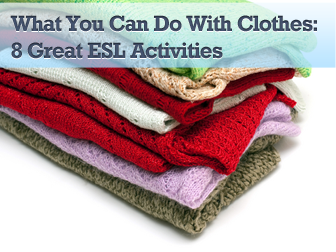What You Can Do with Clothes: 8 Great ESL Activities

What do we usually do when we have to teach fruits and vegetables in English? We use flashcards and illustrations, right? But what if we were to bring a basket full of fruits and not only have students name them, but also take part in a surprise indoor picnic? I can assure you students will be both surprised and thrilled, and even though they may not be in the mood for a fruit salad, one thing is certain: this is one lesson they’ll never forget.
This is what the use of realia in the classroom is all about: the use of real life objects that students can touch, feel, and even smell to effectively teach ESL components.
Here are some great ways to take full advantage of the possibilities offered by the use of realia in the classroom:
 5 o’clock tea
5 o’clock teaThis is by far the best way to teach table manners, requests, or expressions related to ordering or serving tea, coffee, or any meal in a home setting. For the following dialogue:
- Would you like some tea?
- No, thank you.
- What would you like?
- I’d like some coffee, please.
- With milk and sugar?
- Just black coffee.
Simply bring a children’s tea set (it's a lot easier to bring to class) complete with tea cups, saucers, spoons, teapot and/or coffee pot, sugar bowl, creamer, etc... and have students practice offering and serving each other coffee or tea. You may also choose to add cakes, pies, cookies, or anything that will make your 5 o’clock tea truly unforgettable. You can make it as simple or as complete as you wish, or as time allows.
 Eating out
Eating outDesign and print out a simple menu with the food you'd like to teach including starters, main courses, and desserts. In small groups, have one student play the role of waiter and take orders, while the other students order their meals. Then have students switch roles. You may also include as many props as you’d like, like a full table setting to teach tableware vocabulary. Students may ask the waiter for a missing item like a spoon, fork, or napkin.
 Location, location, location!
Location, location, location!To teach prepositions of place take common classroom objects like pens, pencils, books, etc…and place them on or under desks, and around the classroom; then have students simply tell you where each item is, or take turns asking each other where their own personal items are. This also works great for teaching “this”, “that”, “these”, and “those”, as the perspective of having items near and far from you clearly illustrates the differences between the demonstrative pronouns.
 Asking for directions
Asking for directionsGet some real city maps from the local tourist office and give one to each pair of students. Have them take turns asking and giving directions to popular city sights.
 Tell me about your family
Tell me about your familyReal family photos are great for not only learning about relationships but also physical descriptions. Have students bring one family photo each and describe family members. Students may also take turns asking classmates questions.
 Let’s have a fashion show
Let’s have a fashion showChildren love to play dress up, and what a better way for them to learn items of clothing and colors than put them on and strut around the classroom to show off their unique style? Adult learners can also model the clothing they’re wearing.
 Celebrate the holidays
Celebrate the holidaysLearning English is not only about learning to speak in a foreign language. Students should learn about cultural elements as well. Special holidays like Halloween, Thanksgiving, and Christmas offer unique learning opportunities. To teach students about Halloween, plan a celebration complete with pumpkin carving, costume contest, and typical games like bobbing for apples. Give your students the chance to experience the holidays and not just read about them.
 The Job Interview
The Job InterviewDo you have students who will be applying for jobs in English? Try to get your hands on some real job applications and have students practice filling them out in class. You may also conduct job interviews using real life interview questions. This type of practice will not only teach them the vocabulary they should know, it will give students the boost of confidence they need.
 What’s the weather like today?
What’s the weather like today?It’s as easy as starting each class by having students comment on what it’s like outside. You can get as basic or as complex as you like, from simply saying it's “raining”, to it's “drizzling”, “pouring” or even “raining cats and dogs”!
You will have probably realized by now that including realia in the classroom involves a great deal of preparation in some cases. Is it really worth you time? The answer is, yes. Absolutely! And your student’s faces will be living proof.
When it comes to using realia in the classroom the sky’s the limit! The best part is that your students will learn, have fun, but you’ll also enjoy your classes all the more.